Abstract
Although viral illnesses are predisposing causes for pulmonary bacterial infections, the interrelationships of viral virulence and host immunity to alterations in susceptibility to bacterial infection are incompletely understood. We used two mutant strains of encephalomyocarditis virus (minimally virulent Mengo-37A and a highly virulent Columbia SK [Col-SK]) to investigate these interrelationships. Mice that had been immunized to Mengo-37A, and nonimmunized controls, were challenged with aerosols containing 104 plaque-forming units of Mengo-37A or Col-SK per liter. The effect of each viral infection on pulmonary antibacterial activity was assessed 3 days later by measuring the capacity of the lungs to kill inhaled radiophosphorus (32P)-labeled Staphylococcus aureus. The degree of antibacterial dysfunction found was proportional to the virulence of the infecting virus. If the host was immune to the infecting virus, bactericidal function was not impaired by viral challenge. Neither mutant caused significant pulmonary damage; therefore: (i) viral-induced impairment in bactericidal activity reflects, quantitatively, the virulence of the virus and (ii) viral immunity protects pulmonary bacterial defenses by preventing damage to the phagocyte from the virus or its attendant metabolic abnormalities.
Full text
PDF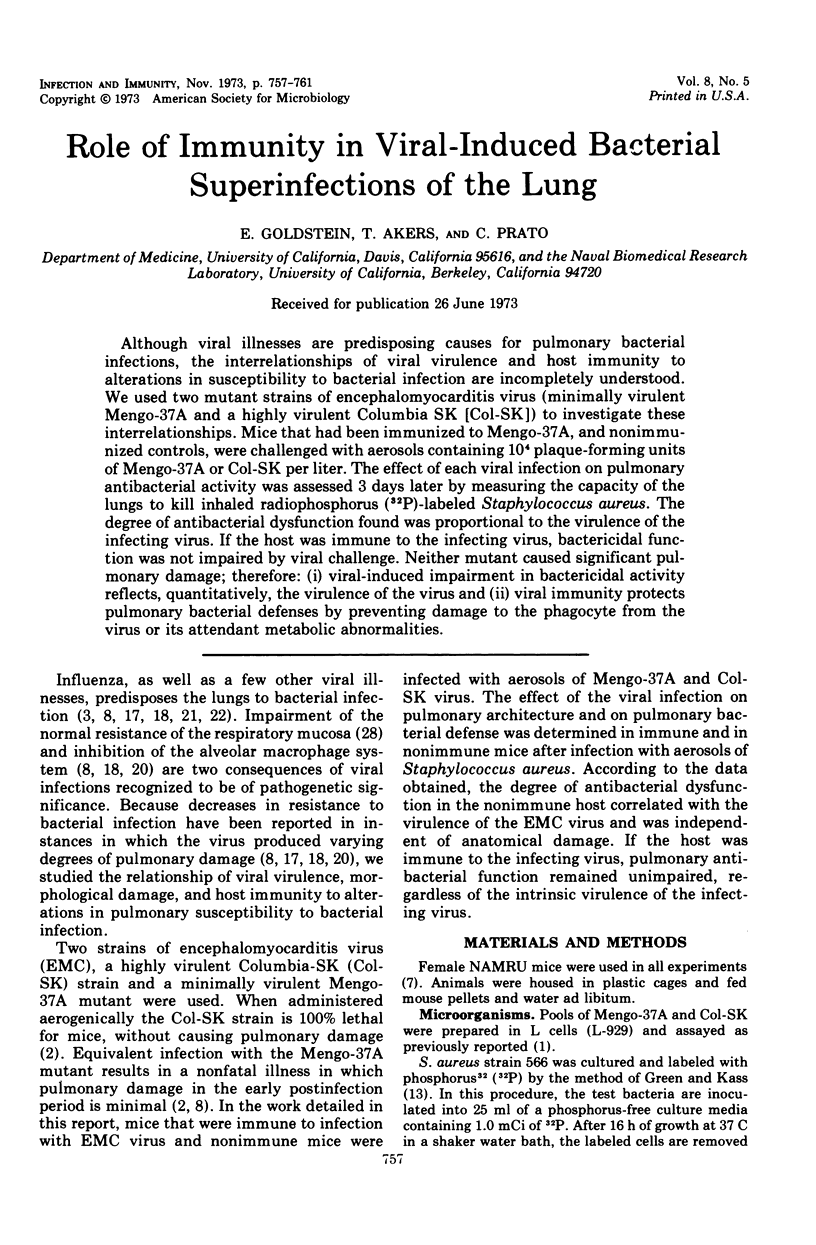
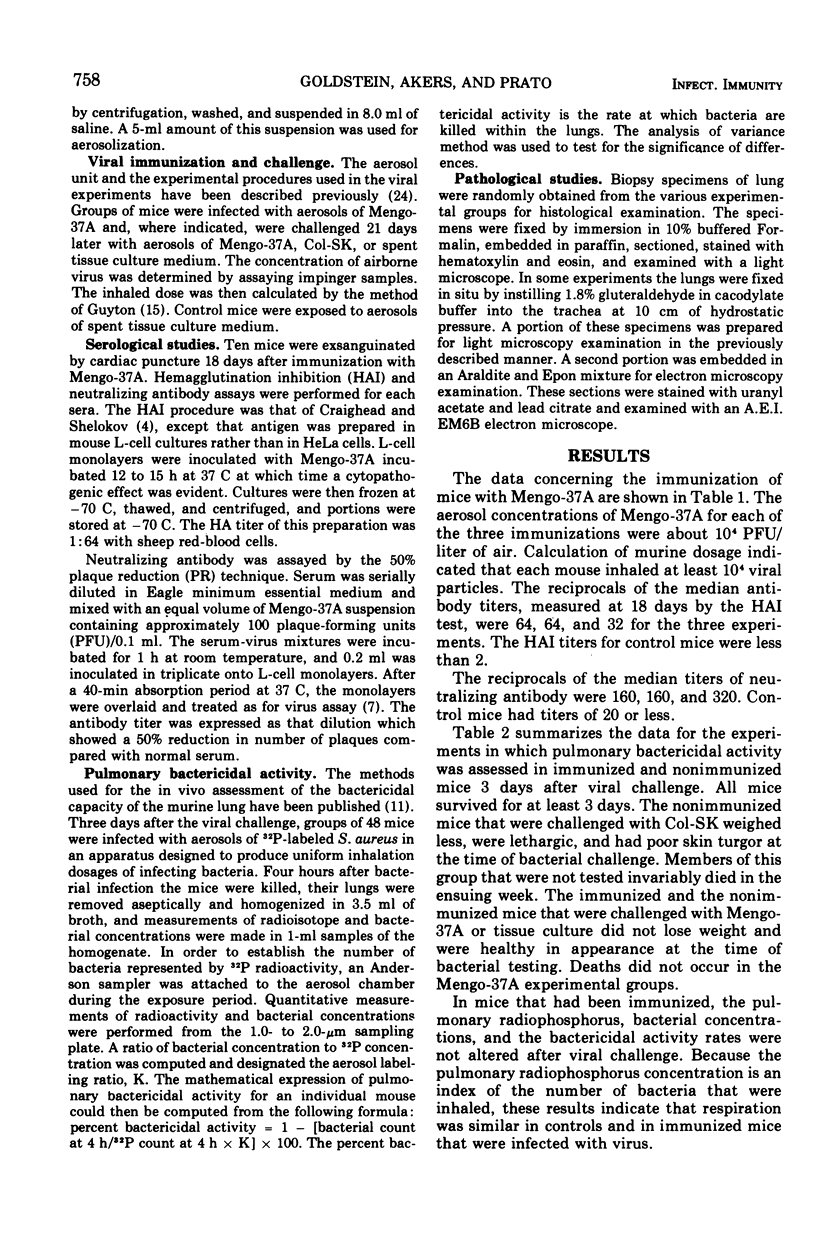
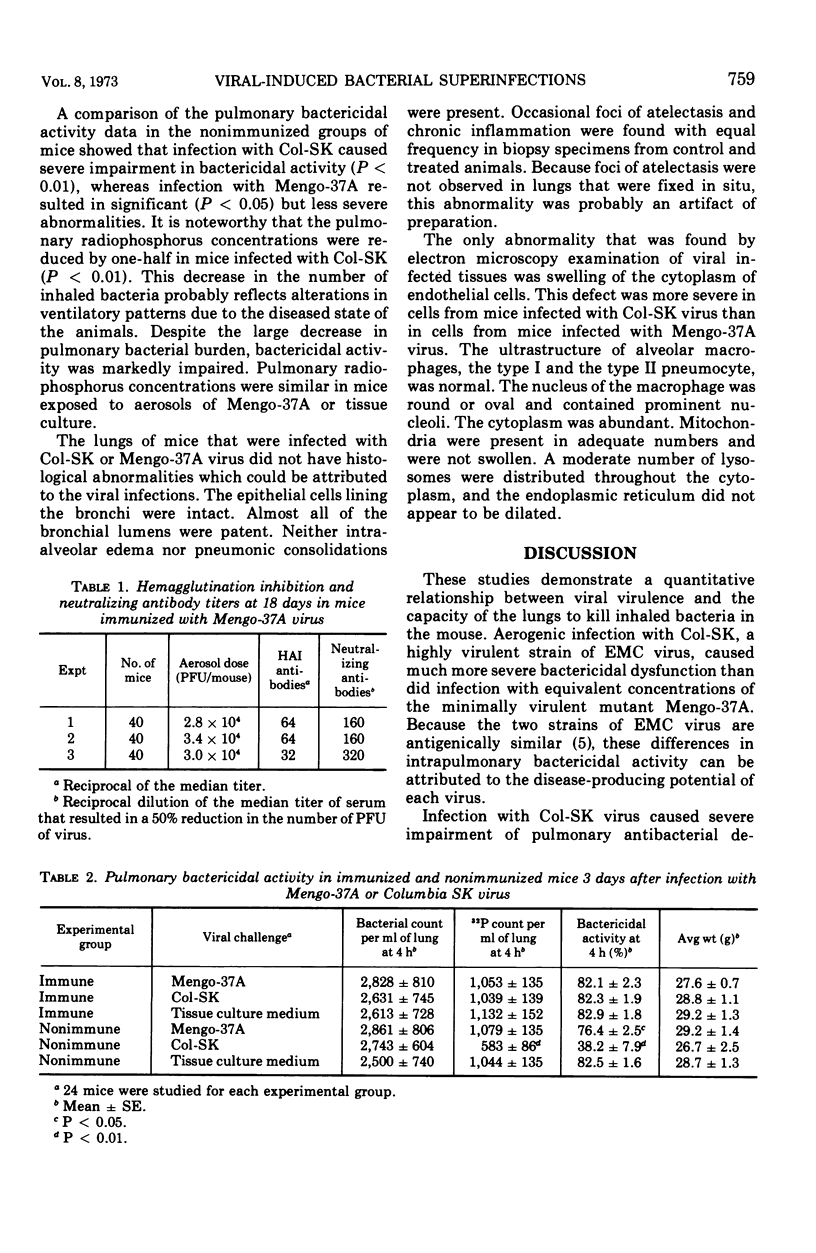
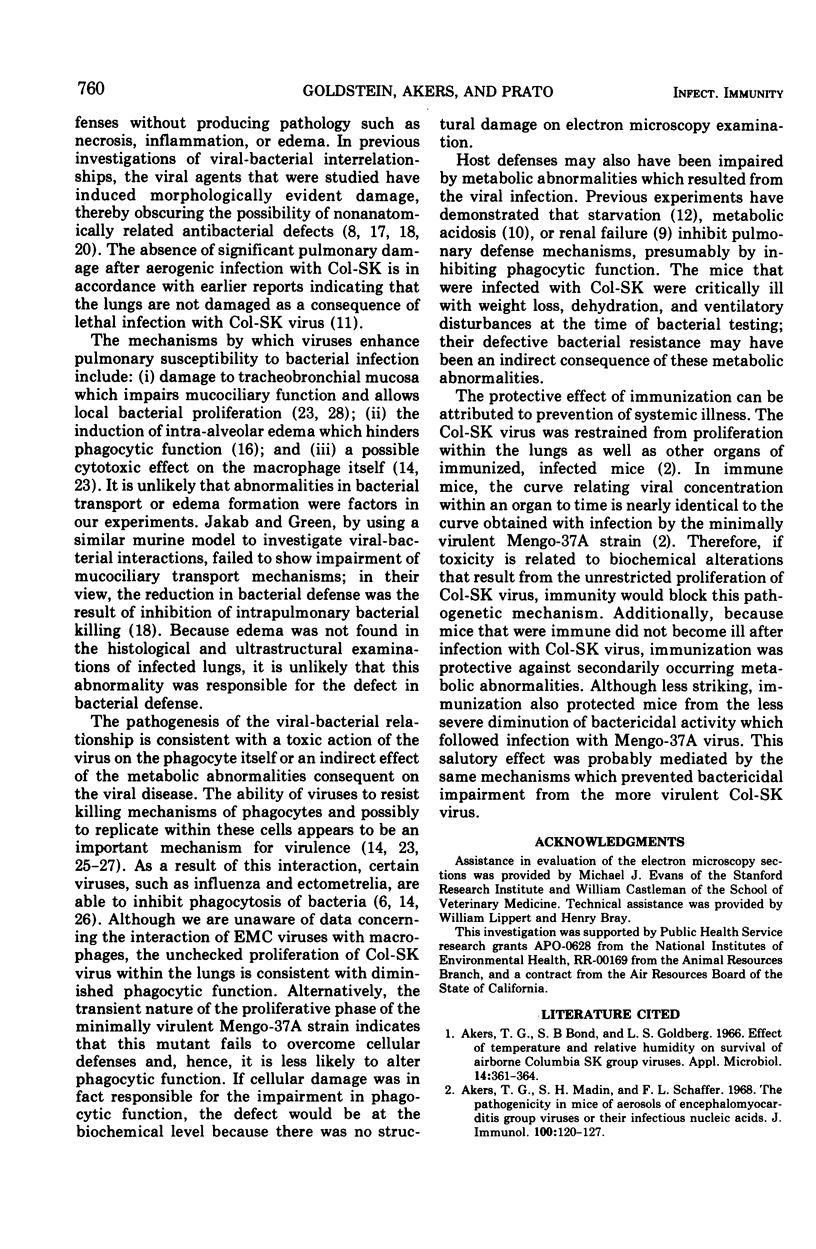
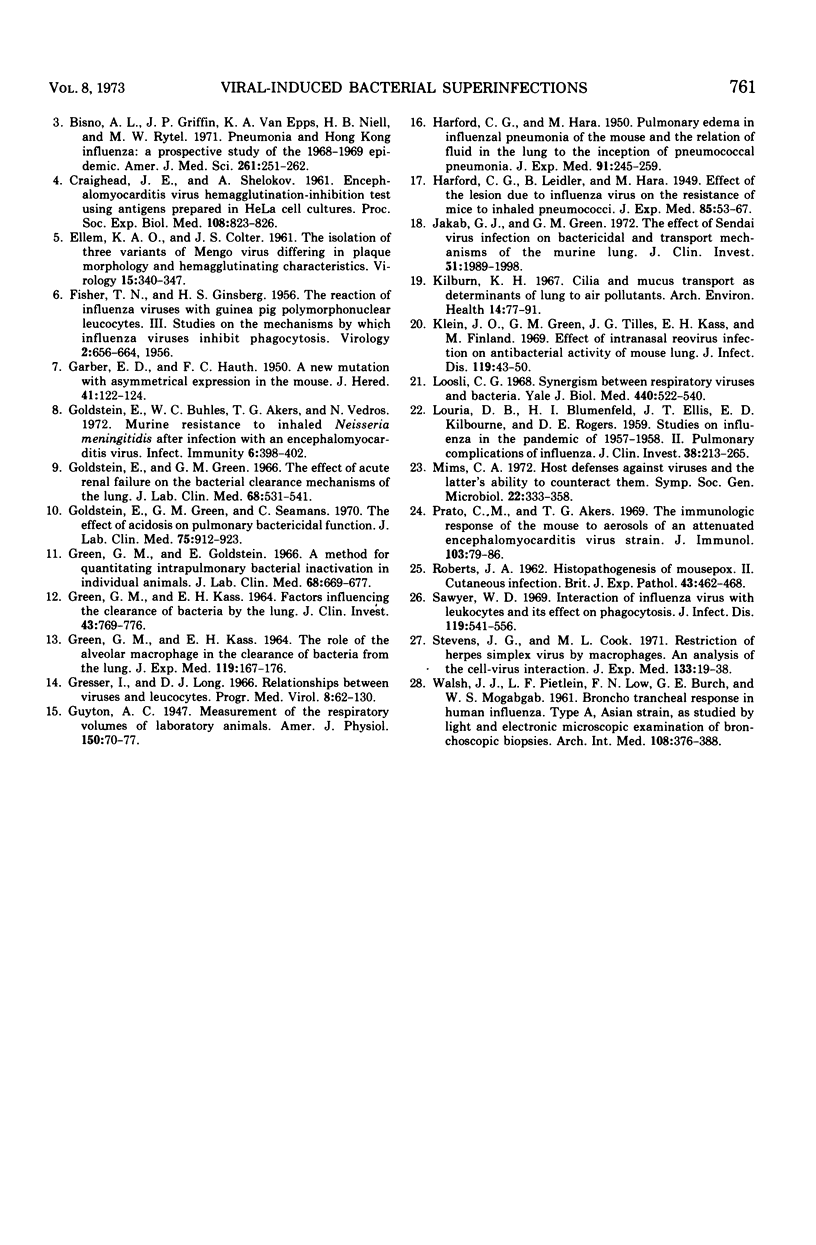
Selected References
These references are in PubMed. This may not be the complete list of references from this article.
- Akers T. G., Bond S., Goldberg L. J. Effect of temperature and relative humidity on survival of airborne Columbia SK group viruses. Appl Microbiol. 1966 May;14(3):361–364. doi: 10.1128/am.14.3.361-364.1966. [DOI] [PMC free article] [PubMed] [Google Scholar]
- Akers T. G., Madin S. H., Schaffer F. L. The pathogenicity in mice of aerosols of encephalomyocarditis group viruses or their infectious nucleic acids. J Immunol. 1968 Jan;100(1):120–127. [PubMed] [Google Scholar]
- Bisno A. L., Griffin J. P., Van Epps K. A., Niell H. B., Rytel M. W. Pneumonia and Hong Kong influenza: a prospective study of the 1968-1969 epidemic. Am J Med Sci. 1971 May;261(5):251–263. doi: 10.1097/00000441-197105000-00004. [DOI] [PubMed] [Google Scholar]
- CRAIGHEAD J. E., SHELOKOV A. Encephalomyocarditis virus hemagglutination-inhibition test using antigens prepared in HeLa cell cultures. Proc Soc Exp Biol Med. 1961 Dec;108:823–826. doi: 10.3181/00379727-108-27080. [DOI] [PubMed] [Google Scholar]
- ELLEM K. A., COLTER J. S. The isolation of three variants of Mengo virus differing in plaque morphology and hemagglutinating characteristics. Virology. 1961 Nov;15:340–347. doi: 10.1016/0042-6822(61)90365-8. [DOI] [PubMed] [Google Scholar]
- FISHER T. N., GINSBERG H. S. The reaction of influenza viruses with guinea pig polymorphonuclear leucocytes. III. Studies on the mechanism by which influenza viruses inhibit phagocytosis. Virology. 1956 Oct;2(5):656–664. doi: 10.1016/0042-6822(56)90045-9. [DOI] [PubMed] [Google Scholar]
- GARBER E. D., HAUTH F. C. A new mutation with asymmetrical expression in the mouse. J Hered. 1950 May;41(5):122–124. doi: 10.1093/oxfordjournals.jhered.a106105. [DOI] [PubMed] [Google Scholar]
- GREEN G. M., KASS E. H. FACTORS INFLUENCING THE CLEARANCE OF BACTERIA BY THE LUNG. J Clin Invest. 1964 Apr;43:769–776. doi: 10.1172/JCI104961. [DOI] [PMC free article] [PubMed] [Google Scholar]
- GREEN G. M., KASS E. H. THE ROLE OF THE ALVEOLAR MACROPHAGE IN THE CLEARANCE OF BACTERIA FROM THE LUNG. J Exp Med. 1964 Jan 1;119:167–176. doi: 10.1084/jem.119.1.167. [DOI] [PMC free article] [PubMed] [Google Scholar]
- Goldstein E., Buhles W. C., Akers T. G., Vedros N. Murine resistance to inhaled Neisseria meningitidis after infection with an encephalomyocarditis virus. Infect Immun. 1972 Sep;6(3):398–402. doi: 10.1128/iai.6.3.398-402.1972. [DOI] [PMC free article] [PubMed] [Google Scholar]
- Goldstein E., Green G. M., Seamans C. The effect of acidosis on pulmonary bactericidal function. J Lab Clin Med. 1970 Jun;75(6):912–923. [PubMed] [Google Scholar]
- Goldstein E., Green G. M. The effect of acute renal failure on the bacterial clearance mechanisms of the lung. J Lab Clin Med. 1966 Oct;68(4):531–542. [PubMed] [Google Scholar]
- Green G. M., Goldstein E. A method for quantitating intrapulmonary bacterial inactivation in individual animals. J Lab Clin Med. 1966 Oct;68(4):669–677. [PubMed] [Google Scholar]
- Gresser I., Lang D. J. Relationships between viruses and leucocytes. Prog Med Virol. 1966;8:62–130. [PubMed] [Google Scholar]
- Jakab G. J., Green G. M. The effect of Sendai virus infection on bactericidal and transport mechanisms of the murine lung. J Clin Invest. 1972 Aug;51(8):1989–1998. doi: 10.1172/JCI107005. [DOI] [PMC free article] [PubMed] [Google Scholar]
- Kilburn K. H. Cilia and mucus transport as determinants of the response of lung to air pollutants. Arch Environ Health. 1967 Jan;14(1):77–91. doi: 10.1080/00039896.1967.10664699. [DOI] [PubMed] [Google Scholar]
- Klein J. O., Green G. M., Tilles J. G., Kass E. H., Finland M. Effect of intranasal reovirus infection on antibacterial activity of mouse lung. J Infect Dis. 1969 Jan;119(1):43–50. doi: 10.1093/infdis/119.1.43. [DOI] [PubMed] [Google Scholar]
- LOURIA D. B., BLUMENFELD H. L., ELLIS J. T., KILBOURNE E. D., ROGERS D. E. Studies on influenza in the pandemic of 1957-1958. II. Pulmonary complications of influenza. J Clin Invest. 1959 Jan;38(1 Pt 2):213–265. doi: 10.1172/JCI103791. [DOI] [PMC free article] [PubMed] [Google Scholar]
- Loosli C. G. Synergism between respiratory viruses and bacteria. Yale J Biol Med. 1968 Apr-Jun;40(5-6):522–540. [PMC free article] [PubMed] [Google Scholar]
- Prato C. M., Akers T. G. The immunologic response of the mouse to aerosols of an attenuated encephalomyocarditis virus strain. J Immunol. 1969 Jul;103(1):79–86. [PubMed] [Google Scholar]
- ROBERTS J. A. Histopathogenesis of mousepox. II. Cutaneous infection. Br J Exp Pathol. 1962 Oct;43:462–468. [PMC free article] [PubMed] [Google Scholar]
- Sawyer W. D. Interaction of influenza virus with leukocytes and its effect on phagocytosis. J Infect Dis. 1969 Jun;119(6):541–556. doi: 10.1093/infdis/119.6.541. [DOI] [PubMed] [Google Scholar]
- Stevens J. G., Cook M. L. Restriction of herpes simplex virus by macrophages. An analysis of the cell-virus interaction. J Exp Med. 1971 Jan 1;133(1):19–38. doi: 10.1084/jem.133.1.19. [DOI] [PMC free article] [PubMed] [Google Scholar]
- WALSH J. J., DIETLEIN L. F., LOW F. N., BURCH G. E., MOGABGAB W. J. Bronchotracheal response in human influenza. Type A, Asian strain, as studied by light and electron microscopic examination of bronchoscopic biopsies. Arch Intern Med. 1961 Sep;108:376–388. doi: 10.1001/archinte.1961.03620090048006. [DOI] [PubMed] [Google Scholar]


